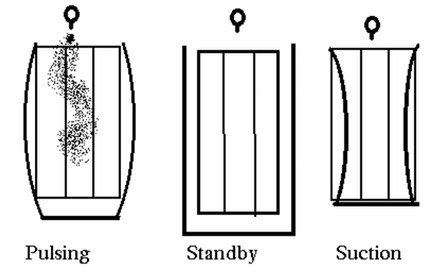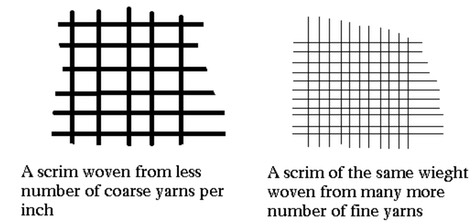Support Fabrics for Needle Felts
The process of manufacturing needle felts involves the interlocking of textile fibres by the action of punching thousands of barbed needles, into a web of textile fibres. It is this mechanical fibre-to-fibre bond, which provides the basis of any tensile strength values that eventualy emerges from the finished felt. Having the fascilities to produce our own scrims in-house, we have pioneered felt designs with 2 layers of scrims (100 gsm each) which has tensile strength values unequalled, even by reputed European manufacturers. These felts are intended to be used in longer filter bags ( 4 metre+ in length), or in installations where there is a history of pressure drop problems, or where very fine particulate is to be filtered at relatively high velocity (fine cement, fumes from arc furnaces, aluminium pot line fumes etc.)
However, the design of needle felts which are meant primarily for use in dust-catcher bags, need to be studied more closely. The effect of long periods of suction, where the bag is sucked around the retaining wire cage, and the brief, but very much more aggressive period of inflation, where the bag is pushed away from the supporting cage during pulsing, places extremely high demands on the tensile strength of felts, particularly those in machine-direction values.
The following exaggerated depiction of a bag during suction, stand-by & pulsing, serves to highlight the immense stresses especially in machine direction, which a felt has be subjected to, during its useful working lifetime.

Traditionally, needle felts were made with the fibres punched into a woven support fabric, (otherwise known as a scrim), to overcome the high demands on machine-direction tensile strength. This woven scrim forms the skeletal backbone of a needle felt, which mantains on one hand, the permemability values which are very important for a filtration felt, and on the other hand, increases the tensile strength values, which are essential & indispensable to resist the severe forces depicted above.
To understand the manufacturing of scrim fabrics, whose design is actually a science within itself, its basic attributes must first be laid down. The main requirements of a scrim are:
Desired basis weight
Desired open area
Desired strength of finished felt
Each of these requirements can be reached by a variety of weave deisgns, so the most optimum one must be chosen. Very often, one requiremnent can be reached but with a direct & significant compromise to another. For example, a scrim made from a 15 ends/inch will be substantially heavier, stronger & denser than one made from, say, 10 ends/inch. But a switch to a finer yarn count can result in a scrim which can also have 15 ends per inch, but which is lighter, yet often as strong, and with more open areawhen compared to the former design.

From the above, it can be perceived that the scrim on the right, which is woven from finer yarns, has the potential to reach a much higher felt tensile strength, due mainly to the higher number of warp & weft intersections, and due to the fact it is made from finer yarns, though each finer yarn initself, is much more weaker when directly compared to a single heavier or caorser yarn used in the design on the left.
It is also of course a matter of basic economical reality, that the cost of weaving a finer scrim is disproportionately higher than weaving a coarser design due to the weaving loom occupation time when compared to linear output, since weaving looms run at more or less fixed speeds irrespective of the fineness os yarn used. The well known fact that that finer yarns, as used in the scrim design on the right, cost much more to produce than coarser yarns, as used in the deisgn on the left, must also be taken into consideration as a very important economcal fact in dictating the design & weight of thre scrim to be chosen in a particular felt design.
The economics of scrim production also require that textile fibres are first converted into a yarn, and then woven in a fabric structure, thereby making the addition of scrims into a felt a significant, but very important cost consideration in itself
It is a combination of these factors, especially when seen in light of the advent of often senseless & cut throat competition presently prevailing in this industry, that has resulted in scrims becoming more and more conspicious, either by their lighter and lighter constructions,and from many felt makers, their complete disappearance, to meet the economical demands from filter bag makers, for lower and lower felt prices.
This is indeed a very dangerous trend, as it has been proved time and again, that the felt flexing cycle is increased in direct proportion to the scrim construction. Stronger scrims also contribute very significantly to the almost total lack of bag house “puffing”, a phenomena which occurs in pulse jet bag houses, when bag-cleaning down takes place; During pulsing, the felt bag expands so as to break the dust cake, and this expansion is controlled by a stronger scrim being able to maintain the felt’s design permeability characteristics, while it is very obvious that a felt with no support scrim or one is insignificantly lighter, cannot adequately withstand such demands of performance for long periods of cyclic operations.
We, as bag makers, who pioneered backward integration into felt production, & then again vertically integrated into our own yarn production, often cannot understand the mentality of buyers who frequently choose to ignore such vital, importarnt & relevant factors, when comparing prices.
We therefore urge our customers to specify the weight of scrims when specifying weight of felts, as there are many perhaps ignorant felt makers who offer to supply filteration felts to bag makers manufactured with a mere token of a scrim. There are known to be felts in the market, which are made with the total absence of any support scrims, but its performance in the long term for use in filter bags, can only be a subject of intense speculation.
Our range of specialised scrims includes scrims woven from:
HIGH TENSILE POLYESTER
POLYPOROPELENE
ACRYLIC
FIBREGLASS
BASALT
100% PTFE (TEFLON) YARNS
P-84 FILAMENT ETC ETC.
